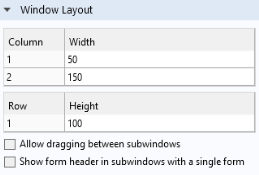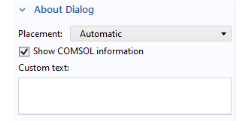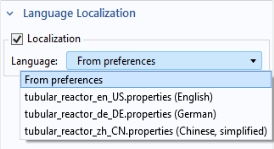In the application tree, the Main Window node represents the main window of an application and is also the top-level node for the user interface. It contains the window layout, the main menu specification, and optional ribbon, and subwindow specifications. The Main Window Editor, visible whenever the
Main Window node is active, lets you design menu bars, ribbon tabs, and subwindows.
The Settings window contains a
General section with the following settings:
The Title is the text at the top of the main window in an application, with the
Icon shown to the far left of this text. By default, the
Title is the same as the title of the model used to create the application. Keep the
Show filename in title checkbox selected if you wish to display the file name of the application to the left of the
Title.
In the Icon list, select an image from the library or add an image (
*.png) from the local file system to the library and use it as an icon. If you add a new image, it will be added to the image library and thereby embedded into the application. You can also export an icon by clicking the
Export button to the right of the
Add Image to Library and Use Here button.
The Main Window node in the application tree has two child nodes, the names and purposes of which depend on the
Menu type setting. There are two available
Menu type options:
Ribbon and
Classic menu. By default, the menu type is set to
Ribbon, which includes the child nodes
File Menu and
Ribbon. When the
Classic menu type is selected, the child nodes are
Menu Bar and
Toolbar.
The Main window type setting lets you select the type of application layout:
Subwindows or
Single window. The
Subwindows option makes it possible to organize forms into subwindows that, while the application is running, can be detached and docked.
The Status bar list controls what is shown in the status bar. From the list, select the
Progress option to display a progress bar, otherwise, select
None. Note that you can also create custom progress bars by writing method code.
The Main Form section is visible if the
Main window type is set to
Single window. It contains a reference to the form that the main window displays.

The Window Layout section is visible if the
Main window type is set to
Subwindows.

In the Size section, the
Initial size setting determines the size of the main window when the application is first started.

There are two or three Initial size options, depending on the
Main window type setting:
|
•
|
Maximized results in the window being maximized when the application is run.
|
|
•
|
For the Single window option, Use main form's size uses the size of the main form; See The Individual Form Settings Windows. The main form is defined by the Main Form section. This option further adds the size required by the main window itself, including: the window frame and title bar, main menu, main toolbar, and ribbon. This size is computed automatically.
|
|
•
|
Manual lets you enter the pixel size for the width and height. In this case, nothing is added to the width and height. When using this option, you need to ensure that there is enough room for the window title, ribbon, and menu bar.
|
In addition, there is a Center on screen checkbox that is applicable to any
Size setting that does not correspond to a maximized window.
When the Main window type is set to
Subwindows, the
Use main form's size option is not applicable and is therefore removed. In this case, the
Initial size is changed to
Maximized.
The About Dialog section contains settings for customizing parts of the
About This Application dialog, which contains legal information.

The Placement option lets you choose between
Automatic,
File menu,
Ribbon,
Lower-right corner, or
Lower-left corner. The
Lower-right corner and
Lower-left corner options are available only when the
Main window type is set to
Single window and will place a hyperlink referencing the
About This Application dialog in the corresponding corner of the application user interface. If selected, the
Show COMSOL information checkbox will display the COMSOL software version and product information. Any text entered in the
Custom text field will be displayed above the legal text in the dialog. In the
Custom text field, words containing
https or
www will be interpreted as hyperlinks, if possible. For example,
https://www.comsol.com or
www.comsol.com will be replaced with a hyperlink.
The Language Localization section contains settings for the localization of the application.

The Localization setting determines whether the application should be localized using language files or not and is disabled by default. The
Language setting specifies the language files that are used for localization. By default, the
From preferences option is selected and the language used when running the application is determined by the language preference setting in COMSOL Multiphysics, COMSOL Server, or a compiled application. For more information on localization, see the
Application Builder Reference Manual.


